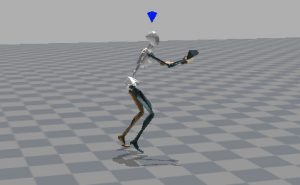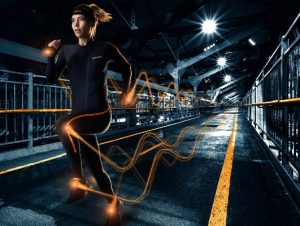[ad_1]
Xsens technology is used by computer games companies, film makers and clinicians to accurately track the movement of limbs and other major body parts. For example, it is used to record the movements of human actors for transfer to animated films or to action games. It is also used by car makers to assess the ease at which people enter and leave vehicles, and in the training of athletes.
It process involves attaching many small multi-axis accelerometer/gyro modules to the subject, either strapped on or in the form of a suit with up to 17 sensing points, and then processing resulting data using its intellectual property: a comprehensive suite of sensor fusion, motion capture and visualisation software.
 Xsens software displaying a computer model of a basketball player, created from a human basketball player wearing motion sensors
Xsens software displaying a computer model of a basketball player, created from a human basketball player wearing motion sensors
mCube’s speciality is miniature accelerometers – some that are 1.1 x 1.3 x 0.74mm – small even by current phone component standards. It also makes magnetometers, and it has a gyro in the pipeline.
It is fabless, and its intellectual property lies in making and sealing MEMS sensors on top of CMOS without space-eating bond wires – by micro-machining two wafers and bonding them to a CMOS wafer (see diagram). More than 300 million mCube motion sensors have been shipped.
 mSens avoids using bond wires to connect a CMOS wafer to a micromachined wafer by bonding the mems directly to the CMOS. A crucial deep-etched via, made using a patented technique, makes the electrical connection to the MEMS proof-mass for capacitive sensing. A third wafer seals the sensor to maintain a vacuum.
mSens avoids using bond wires to connect a CMOS wafer to a micromachined wafer by bonding the mems directly to the CMOS. A crucial deep-etched via, made using a patented technique, makes the electrical connection to the MEMS proof-mass for capacitive sensing. A third wafer seals the sensor to maintain a vacuum.
Having combined the two companies, “ultimately, as we make the sensors smaller and lower cost, we want to get Xsens’ sensing down to consumer level”, mCube CEO Ben Lee told Electronics Weekly. “We want to create the technology to send a physiotherapy patient home with sensors so the physiotherapist can deliver remote coaching information. At some point, this should be so easy to use, that it becomes self-help.”
Industrial users are already knocking on mCube’s door for more than just sensor hardware. For example, mCube is involved in a project to enable ‘smart pipes’ for use underground in earthquake zones, which can report their own tilt pre-and post quake, so that estimates can be made of which pipe-to-pipe joints need repairing.
“As a sensor company, we are continually being asked to do system architecture and system solutions,” said Lee. “It would take us years to build the necessary software expertise to take this on on our own, so we are buying a software company.”
According to Lee, he had had his eye on Xsens for several years, which has been owned by Fairchild since 2014. When On Semi recently acquired Fairchild for its standard products, On has no use for a motion sensing company and by coincidence sought out mCube as a potential buyer.
Xsens will retain its brand and continue to operate from its current base in Enschede as a stand-alone business unit of mCube.
Proposed markets for joint developments include: consumer, industrial, medical, sports science, autonomous vehicle and entertainment.
[ad_2]
Source link

